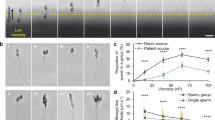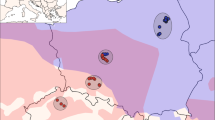Abstract
Spermatozoa from a single male will compete for fertilization of ova with spermatozoa from another male when present in the female reproductive tract at the same time1. Close genetic relatedness predisposes individuals towards altruism, and as haploid germ cells of an ejaculate will have genotypic similarity of 50%, it is predicted that spermatozoa may display cooperation and altruism to gain an advantage when inter-male sperm competition is intense2. We report here the probable altruistic behaviour of spermatozoa in an eutherian mammal. Spermatozoa of the common wood mouse, Apodemus sylvaticus, displayed a unique morphological transformation resulting in cooperation in distinctive aggregations or ‘trains’ of hundreds or thousands of cells, which significantly increased sperm progressive motility. Eventual dispersal of sperm trains was associated with most of the spermatozoa undergoing a premature acrosome reaction. Cells undergoing an acrosome reaction in aggregations remote from the egg are altruistic in that they help sperm transport to the egg but compromise their own fertilizing ability.
This is a preview of subscription content, access via your institution
Access options
Subscribe to this journal
Receive 51 print issues and online access
$199.00 per year
only $3.90 per issue
Buy this article
- Purchase on SpringerLink
- Instant access to full article PDF
Prices may be subject to local taxes which are calculated during checkout




Similar content being viewed by others
References
Birkhead, T. R. & Moller, A. P. Sperm Competition and Sexual Selection (Academic, London, 1996)
Trivers, R. Social Evolution (Benjamin Cummings, California, 1985)
Sivinski, J. in Sperm Competition and the Evolution of Animal Mating Systems (ed. Smith, R. L.) 223–249 (Academic, Orlando, 1984)
Hayashi, F. Insemination through an externally attached spermatophore: bundled sperm and post-copulatory mate guarding by male fishflies (Megaloptera: corydalidae). J. Insect Physiol. 42, 859–866 (1996)
Moore, H. D. Gamete biology of the new world marsupial, the grey short-tailed opossum, Monodelphis domestica. Reprod. Fertil. Dev. 8, 605–615 (1996)
Hamilton, W. D. The genetical evolution of social behaviour. I. J. Theor. Biol. 7, 1–16 (1964)
Shepherd, B. A. & Martan, J. Morphology and fertility of guinea-pig spermatozoa aged in vivo. Arch. Androl. 2, 53–58 (1979)
Baker, R. R. & Bellis, M. A. Kamikaze sperm in mammals? Anim. Behav. 36, 936–939 (1988)
Baker, R. R. & Bellis, M. A. Human Sperm Competition (Chapman Hall, London, 1995)
Moore, H. D., Martin, M. & Birkhead, T. R. No evidence for killer sperm or other selective interactions between human spermatozoa in ejaculates of different males in vitro. Proc. R. Soc. Lond. B 266, 2243–2350 (1999)
Hanak, V. & Mazak, V. Mammals (Aventinum, Prague, 1979)
Breed, W. G. & Taylor, J. Body mass, testes mass and sperm size in murine rodents. J. Mamm. 81, 758–768 (2000)
Bedford, J. M. in The Spermatozoon (eds Fawcett, D. W. & Bedford, J. M.) 7–21 (Urban and Schwarzenberg, Baltimore, 1979)
Harcourt, A. H., Harver, P. H., Larson, S. G. & Short, R. V. Testes weight, body weight and breeding systems in primates. Nature 293, 55–57 (1981)
Tew, T. E. & Macdonald, D. W. Dynamics of space use and male vigor amongst wood mice, Apodemus sylvaticus in the cereal ecosystem. Behav. Ecol. Sociobiol. 34, 337–345 (1994)
Yanagimachi, R. in Physiology of Reproduction (eds Knobil, E. & Neil, J.) 189–317 (Raven Press, New York, 1994)
Friend, G. F. The sperms of British muridae. Quart. J. Micro. Sci. 78, 419–443 (1936)
Moore, H. D., Hartman, T. D., Brown, A. C., Smith, C. A. & Ellis, D. A. Expression of sperm antigens during spermatogenesis and maturation detected with monoclonal antibodies. Exp. Clin. Immunogenet. 2, 84–96 (1985)
Fraser, L. R. & Drury, L. M. The relationship between sperm concentration and fertilisation in vitro of mouse eggs. Biol. Reprod. 13, 513–518 (1975)
Moore, H. D. & Akhondi, M. A. Fertilizing capacity of rat spermatozoa is correlated with decline in straight-line velocity measured by continuous computer-aided sperm analysis. J. Androl. 17, 50–60 (1996)
Holt, C., Holt, W. V., Moore, H. D., Reed, H. C. & Curnock, R. M. Objectively measured boar sperm parameters correlate with the outcome of on-farm inseminations. Results of two fertility trials. J. Androl. 18, 312–323 (1996)
Birkhead, T. R., Martinez, J. G., Burke, T. & Froman, D. P. Sperm mobility determines the outcome of sperm competition in the domestic fowl. Proc. R. Soc. Lond. B 266, 1–6 (1999)
Dawkins, R. The Selfish Gene (Oxford Univ. Press, Oxford, 1976)
Haig, D. Gestational drive and green-bearded placenta. Proc. Natl Acad. Sci. USA 93, 6547–6551 (1996)
De Kretser, D. M. & Kerr, J. B. in Physiology of Reproduction (eds Knobil, E. & Neil, J.) 1177–1290 (Raven Press, New York, 1994)
Kleene, K. C. A possible meiotic function of the peculiar patterns of gene expression in mammalian spermatogenic cells. Mech. Dev. 106, 3–23 (2001)
Kim, E., Waters, S. H., Hake, L. E. & Hecht, N. B. Identification and developmental expression of a smooth muscle gamma-actin in post-meiotic male germ cells of mice. Mol. Cell Biol. 9, 1875–1881 (1989)
Xu, X., Toselli, P. A., Russell, L. D. & Seldin, D. C. Globozoospermia in mice lacking the casein kinase II α catalytic subunit. Nature Genet. 23, 118–121 (1999)
Wassarman, P. M., Jovine, L. & Litscher, E. S. A profile of fertilization in mammals. Nature Cell Biol. 3, E59–E64 (2000)
Acknowledgements
We thank J. Waters for advice on wood mice husbandry. K.D. was supported by an Erasmus Exchange studentship.
Author information
Authors and Affiliations
Corresponding author
Ethics declarations
Competing interests
The authors declare that they have no competing financial interests.
Rights and permissions
About this article
Cite this article
Moore, H., Dvoráková, K., Jenkins, N. et al. Exceptional sperm cooperation in the wood mouse. Nature 418, 174–177 (2002). https://doi.org/10.1038/nature00832
Received:
Accepted:
Issue Date:
DOI: https://doi.org/10.1038/nature00832



